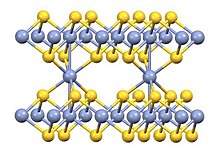
| |
| Identifiers | |
|---|---|
| ECHA InfoCard | 100.031.477 |
| EC Number |
|
PubChem CID
|
|
CompTox Dashboard (EPA)
|
|
| Properties | |
| Cr2S3 | |
| Molar mass | 200.19 g/mol |
| Appearance | Brown to black powder |
| Odor | odorless |
| Density | 3.77 g/cm3 |
| Melting point | 1350 °C |
| insoluble | |
| +2390.0·10−6 cm3/mol | |
| Hazards | |
| NFPA 704 (fire diamond) | |
| NIOSH (US health exposure limits): | |
PEL (Permissible)
|
TWA 1 mg/m3[1] |
REL (Recommended)
|
TWA 0.5 mg/m3[1] |
IDLH (Immediate danger)
|
250 mg/m3[1] |
| Safety data sheet (SDS) | [1] |
| Related compounds | |
Other anions
|
Chromium(III) oxide Chromium(III) telluride |
Except where otherwise noted, data are given for materials in their standard state (at 25 °C [77 °F], 100 kPa).
| |
Chromium(III) sulfide is the inorganic compound with the formula Cr2S3. It is a brown-black solid. Chromium sulfides are usually nonstoichiometric compounds, with formulas ranging from CrS to Cr0.67S (corresponding to Cr2S3).
Preparation
[edit]Chromium(III) sulfide can be prepared through the reaction of a stoichiometric mixture of the elements at 1000 °C[2]
It is a solid that is insoluble in water. According to X-ray crystallography, its structure is a combination of that of nickel arsenide (1:1 stoichiometry) and Cd(OH)2 (1:2 stoichiometry). Some metal-metal bonding is indicated by the short Cr-Cr distance of 2.78 Å.[3]
See also
[edit]- Brezinaite, a mineral with the formula Cr3S4
References
[edit]- ^ a b c NIOSH Pocket Guide to Chemical Hazards. "#0141". National Institute for Occupational Safety and Health (NIOSH).
- ^ Georg Brauer: Handbuch der präparativen anorganischen Chemie. 3., umgearb. Auflage. Band III. Enke, Stuttgart 1981, ISBN 3-432-87823-0, S. 1493
- ^ Jellinek, F. "The structures of the Chromium Sulphides" Acta Crystallographica 1957, volume 10, p620-p628 doi:10.1107/S0365110X57002200


Well, that’s interesting to know that Psilotum nudum are known as whisk ferns. Psilotum nudum is the commoner species of the two. While the P. flaccidum is a rare species and is found in the tropical islands. Both the species are usually epiphytic in habit and grow upon tree ferns. These species may also be terrestrial and grow in humus or in the crevices of the rocks.
View the detailed Guide of Psilotum nudum: Detailed Study Of Psilotum Nudum (Whisk Fern), Classification, Anatomy, Reproduction